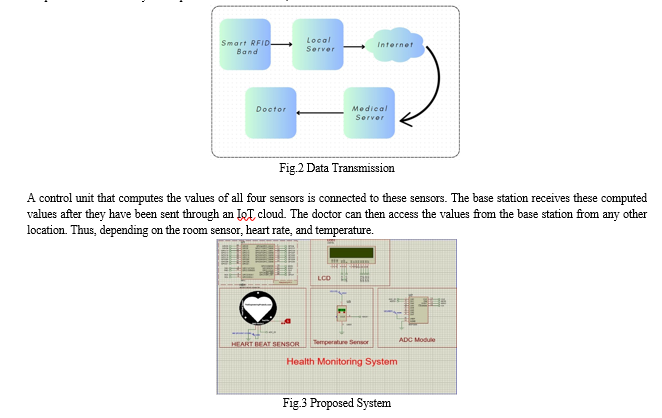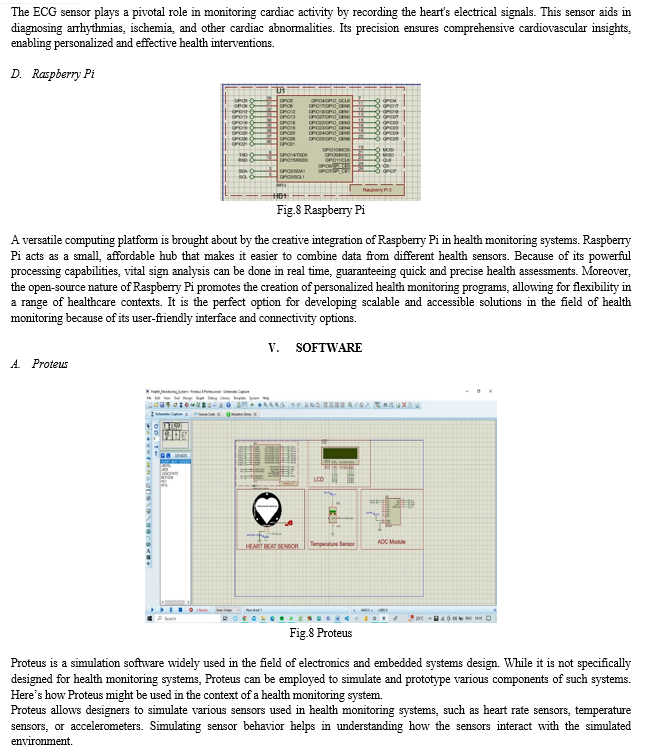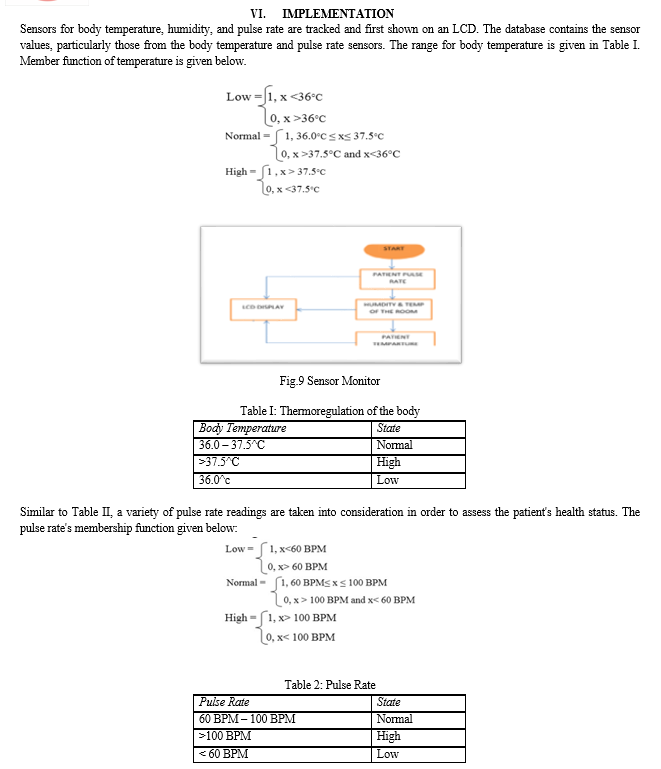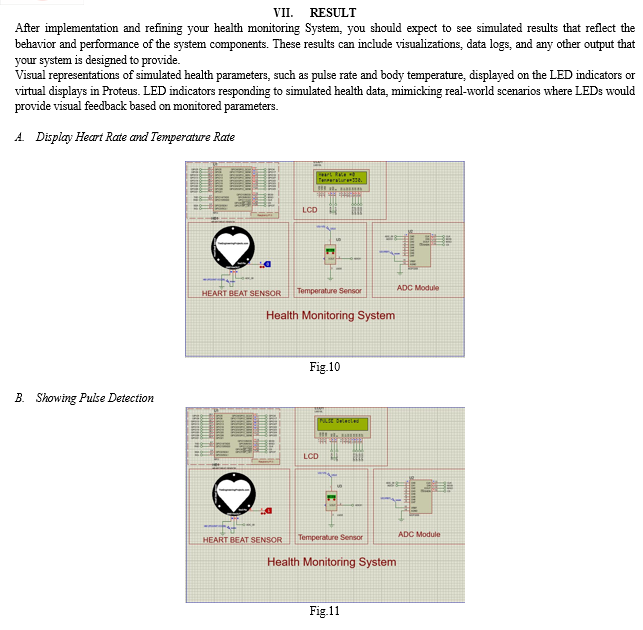Ijraset Journal For Research in Applied Science and Engineering Technology
- Home / Ijraset
- On This Page
- Abstract
- Introduction
- Conclusion
- References
- Copyright
IoT-Enabled Health Monitoring Systems: Transforming Healthcare Delivery
Authors: Bhanu Yadav, Aryan Gupta, Neha Sharma, Yashika Sharma
DOI Link: https://doi.org/10.22214/ijraset.2024.58516
Certificate: View Certificate
Abstract
The Internet of Things (IoT) technology integrated with healthcare has revolutionized the way we monitor and manage health. This research paper presents a comprehensive study and exploration of a Health Monitoring System (HMS) built upon using IoT technologies and principles. The HMS offers numerous advantages, which includes, reduced healthcare cost increased accessibility to healthcare services, enhanced patient outcomes, ultimately improving the quality of life. The core features of the HMS include a diverse array of IoT devices such as wearable sensors, smart medical equipment, and smartphones, which collect real-time health data. This data is then seamlessly transmitted, using advanced communication protocols, to centralized servers for analysis and interpretation. The system employs sophisticated data analytics and machine learning algorithms, providing healthcare professionals with invaluable insights into patient health. The technical architecture of the HMS is clarifying, illuminate on how these components synergic operate to create a robust system. However, we also address potential challenges and limitations, encompassing security concerns, data privacy, and scalability issues. These challenges underscore the importance of a balanced approach to ensure patient data confidentiality and system reliability. In conclusion, this research highlights the transformative potential of IoT-driven Health Monitoring Systems. The implications of integrating these two field helps not only improved healthcare outcomes but also hefty cost savings and increased access to healthcare services.
Introduction
I. INTRODUCTION
The growth of healthcare is accompanied by rapid technological advancements, particularly in the wake of the recent Coronavirus outbreak that negatively impacts China's economy. Technology that monitors remote health offers a promising solution for managing patients during epidemics. IoT-based health monitoring systems offer cutting-edge solutions in this regard. [1].

The Internet of Things (IoT) is a huge network of networked objects that exchange data easily because of its embedded electronics, sensors, software, and connectivity. People, machines, and the environment can all communicate remotely with one another at any time and from any location because to this complex network of gadgets. IoT is essential to patient monitoring in the healthcare industry since it enables medical professionals to monitor patient health data remotely and take immediate action. Remote Patient Monitoring enabling patients to receive care from the comfort of their homes which extends beyond the confines of traditional clinical settings. This innovative approach expands access to medical services while simultaneously reducing accessory costs [2].
The central goal of this project is to create and implement a smart patient health monitoring system that utilizes sensors which includes Heartbeat sensor, temperature sensor, ECG sensor to gather patient health data and employs the internet to notify their family members in case of any anomalies. This system aims to minimize the need for in-person physician visits (such as doctor, nurse), hospital stays, and diagnostic testing procedures. [3]
Human bodies generate valuable health data, including pulse rate, body temperature. This data can be continuously monitored using sensors which collects data from patient connected to a microcontroller. The microcontroller (ATmega328P, RP2040 chip) processes the data and displays it on an LCD screen. Additionally, the system can send alerts to
remote users via the internet if any sudden changes in vital signs are detected. This IoT-based patient monitoring system allows for real-time tracking of health status and timely intervention when necessary, potentially reducing the need for in-person doctor visits and hospital stays [4].
In remote areas, where medical facilities are often unable to be reached, people often ignore minor health issues, such as dysregulation in body temperature and heart rate, until they become lethal or life threatening. This can lead to unnecessary medical expenses and even several consequences. To cover this issue, providing remote patient monitoring systems, equipped with smart sensors, could be a cost-effective and life-saving solution [5][6].
The development in field of IoT-based HMS has empowered common people to access important physiological data from the comfort of their homes. This integration of healthcare with IoT has revolutionized for elderly patients, eliminating the need for involving and exhausting trips to the hospital. Our proposed study installs a selection of specialized bio sensors to monitor vital parameters such as heart rate, oxygen saturation levels, and body temperature.[7]
II. LITERATURE REVIEW
A. Introduction
A health monitoring system was implemented and designed to monitor basic patient symptoms, including body temperature, oxygen saturation (SpO2), heart rate, and eye movement, using an IoT Sensor. The system employed Heartbeat, SpO2, Temperature, and Eye blink sensors for data acquisition and Raspberry Pi or Arduino-UNO board for processing. While the system was successfully implemented, no specific performance metrics regarding patient monitoring we provided [8].
Presented a healthcare monitoring kit using the Internet of Things (IoT) interface. The method effectively takes record of fundamental health parameters, such as respiration, heartbeat, body temperature, and ECG. The primary hardware components employed were a pulse sensor, temperature sensor, BP sensor, ECG sensor, and microprocessor Raspberry Pi. Sensor collects data from patient and transmitted to the Raspberry Pi for processing, followed by further transmission to the IoT network and cloud. The system's primary drawback was the absence of data reading and data visualization section [9].
Suggested an easy approach for detecting pulse rates in a system. The suggested system was a real-time monitoring tool since it employed the plethysmography procedure and digitally showed the results. When compared to other intrusive treatments, the patient has found the method to be dependable. [10].
In this proposed system, a heart rate monitoring device that runs on a smartphone. The device tracked finger blood flow using a mobile light and camera, calculating cardiac output based on blood flow. The devised technology allowed users to
check their heart rate without constantly moving their hands
by describing an integrated gadget that wirelessly sent a person's pulse to a computer. Although this idea is great, it cannot be implemented if continuous cardiac monitoring is required [11].
They created an IoT safety monitoring gadget that is adaptable. Three levels comprise the framework configuration: the control layer, the device layer, and the transport layer. In the control section, a DS18B20 sensor was utilized to monitor body temperature, and a pulse sensor was employed to measure pulse. On the transport layer, the Ethernet shield and Wi-Fi module allowed the data to be loaded from Arduino into the cloud. The server information was ultimately gathered by the framework layer. Unfortunately, since an Arduino Uno was utilized in this instance, many sensors cannot be handled correctly. [12]
In this they created an IoT safety monitoring gadget that is adaptable. Three levels comprise the framework configuration: the control layer, the device layer, and the transport layer. In the control section, a DS18B20 sensor was utilized to monitor body temperature, and a pulse sensor was employed to measure pulse. On the transport layer, the Ethernet shield and Wi-Fi module allowed the data to be loaded from Arduino into the cloud. The server information were ultimately gathered by the framework layer. Unfortunately, since an Arduino Uno was utilized in this instance, many sensors cannot be handled correctly. [13]
B. Proposed System
The creation and deployment of an intelligent patient health tracking system is the main goal of this project. The proposed system's overview is displayed in Fig. 1. The patient's body has embedded sensors to monitor their heart rate and temperature. To monitor the temperature and humidity in the patient's room at home, two additional sensors are installed.

C. Identification of Problem
In the realm of Health Monitoring Systems based on the Internet of Things (IoT), a critical aspect is identifying and addressing existing challenges. The core problem lies in the need for more effective and accessible healthcare solutions. Traditional healthcare systems often fall short in providing timely and remote monitoring, resulting in inadequate preventive measures and increased healthcare costs. This identification prompts the exploration of an IoT-based approach to revolutionize health monitoring, seeking to overcome barriers related to real-time data transmission, data security, and the integration of advanced analytics. By pinpointing these challenges, this project endeavors to contribute to the enhancement of healthcare systems through innovative IoT solutions.
III. METHODOLOGY
A. Sensor Selection and Integration
Identify the health parameters to be monitored (e.g., heart rate, temperature, activity level). Choose appropriate sensors capable of measuring these parameters accurately and reliably. Integrate selected sensors into a cohesive system, ensuring seamless communication and interoperability.
Components:
- Heart Rate Sensor
- Temperature sensor (e.g., LM35)
- LED displays for visual feedback
- Raspberry Pi
Circuit Design: Use the Proteus workspace to design the circuit. Connect the pulse sensor and temperature sensor to the microcontroller. Add LED displays for visual feedback.
Select Components: Drag and drop components from the Proteus library, choosing the appropriate models for the pulse sensor, temperature sensor, microcontroller, and LED displays.
Wiring: Connect the components using appropriate wiring. Ensure correct connections between the sensor outputs and the microcontroller inputs. Connect LED displays for visualizing data.
Firmware Development: Write the firmware code for the microcontroller. Use the microcontroller's programming environment (e.g., Arduino IDE) to code the logic for reading data from the pulse sensor and temperature sensor.
Simulation: Launch the Proteus simulation and run the simulation script. Observe how the LED displays react to simulated data from the pulse and temperature sensors.
Data Visualization: Use Proteus tools to visualize data, or integrate external visualization tools to represent health data trends over time.
Debugging: If issues arise during simulation, use Proteus debugging tools to identify and address potential problems in the circuit or firmware code.
Iterative Testing: Make adjustments to the circuit or firmware based on simulation results. Iterate through testing and refinement until the simulated health monitoring system behaves as expected.





VIII. FUTURE
The Future of health monitoring system holds exciting, the possibilities driven by advancements in technology, data analytics, and the growing emphasis on preventive healthcare.
Wearable devices will likely play an increasingly central role in health monitoring. Future wearables may incorporate more advanced sensors, improved from factors, and enhanced connectivity to provide real-time and continuous health data.
The integration of Artificial Intelligence(AI) and Machine Learning(ML) Algorithms will enable more sophisticated analysis of health data. These technologies can identify patterns, predict health trends, and offer personalized insights for users.
The expansion of remote patient monitoring will allow healthcare providers to monitor patients in real-time, leading to more timely interventions, reduced hospitalizations, and Improved overall patient outcomes.
Conclusion
Nowadays, the Internet of Things is thought to be one of the practical answers for any kind of remote value tracking, particularly in the area of health monitoring. It makes it easier for each person\'s prosperity parameter data to be safely stored in the cloud, shortens hospital stays for standard routine exams, and—above all—allows any doctor, wherever they may be in the world, to monitor their health and diagnose illnesses. An IoT-based health monitoring system was created and presented in this paper. Sensors used by the system to measure room temperature, body temperature, pulse rate, and humidity were also shown on an LCD. Wireless communication is then used to send these sensor values to a medical server. An authorized personal smartphone with an IoT platform then receives these data.
References
[1] Rathi V.K., Rajput N.K., Mishra S., Grover B.A., Tiwari P Jaiswal A.K., Hossain M.S. An edge AI-enabled IoT healthcare monitoring system for smart cities. Comput. Electr. Eng. 2021 ;96:107524. doi: 10.1016/j.compeleceng.2021.107524.[CrossRef] [Google Scholar] [2] Reddy DL, Naik MR, Srikar D. Health monitoring system based on IoT. In2021 5th International Conference on Trends in Electronics and Informatics (ICOEI) 2021 Jun 3 (pp. 468-472). IEEE. [3] Kadhim, Kadhim Takleef, Ali M. Alsahlany, Salim Muhsin Wadi, and Hussein T. Kadhum. \"An overview of patient’s health status monitoring system based on internet of things (IoT).\" Wireless Personal Communications 114, no. 3 (2020): 2235-2262. [4] Kadhim, K.T., Alsahlany, A.M., Wadi, S.M. and Kadhum, H.T., 2020. An overview of patient’s health status monitoring system based on internet of things (IoT). Wireless Personal Communications, 114(3), pp.2235-2262. [5] Siam, A.I., Abou Elazm, A., El-Bahnasawy, N.A., El Banby, G., Abd El-Samie, F.E. and Abd El-Samie, F.E., 2019. Smart health monitoring system based on IoT and cloud computing. Menoufia journal of electronic engineering research, 28(1), pp.37-42. [6] Tamilselvi, V., S. Sribalaji, Palanisamy Vigneshwaran, P. Vinu, and J. GeethaRamani. \"IoT based health monitoring system.\" In 2020 6th International conference on advanced computing and communication systems (ICACCS), pp. 386-389. IEEE, 2020. [7] Khan, Mohammad Monirujjaman, Turki M. Alanazi, Amani Abdulrahman Albraikan, and Faris A. Almalki. \"IoT-based health monitoring system development and analysis.\" Security and Communication Networks 2022 (2022). [8] Ru, Lei, Bin Zhang, Jing Duan, Guo Ru, Ashutosh Sharma, Gaurav Dhiman, Gurjot Singh Gaba, Emad Sami Jaha, and Mehedi Masud. \"A detailed research on human health monitoring system based on internet of things.\" Wireless Communications and Mobile Computing 2021 (2021): 1-9. [9] Balakrishnan, S., K. Suresh Kumar, L. Ramanathan, and S. K. Muthusundar. \"IoT for health monitoring system based on machine learning algorithm.\" Wireless Personal Communications (2022): 1-17. [10] Bhardwaj, H., Bhatia, K., Jain, A. and Verma, N., 2021, July. IOT based health monitoring system. In 2021 6th International Conference on Communication and Electronics Systems (ICCES) (pp. 1-6). IEEE. [11] Ruman, Md Raseduzzaman, Amit Barua, Waladur Rahman, Khan Roushan Jahan, Md Jamil Roni, and Md Foyjur Rahman. \"IoT based emergency health monitoring system.\" In 2020 International Conference on Industry 4.0 Technology (I4Tech), pp. 159-162. IEEE, 2020. [12] Bhardwaj, V., Joshi, R. and Gaur, A.M., 2022. IoT-based smart health monitoring system for COVID-19. SN Computer Science, 3(2), p.137 [13] https://ieeexplore.ieee.org/document/8899434\\\\ [14] https://www.researchgate.net/figure/Literature- [15] https://www.researchgate.net/figure/IoT-based
Copyright
Copyright © 2024 Bhanu Yadav, Aryan Gupta, Neha Sharma, Yashika Sharma. This is an open access article distributed under the Creative Commons Attribution License, which permits unrestricted use, distribution, and reproduction in any medium, provided the original work is properly cited.

Download Paper
Paper Id : IJRASET58516
Publish Date : 2024-02-20
ISSN : 2321-9653
Publisher Name : IJRASET
DOI Link : Click Here
 Submit Paper Online
Submit Paper Online

